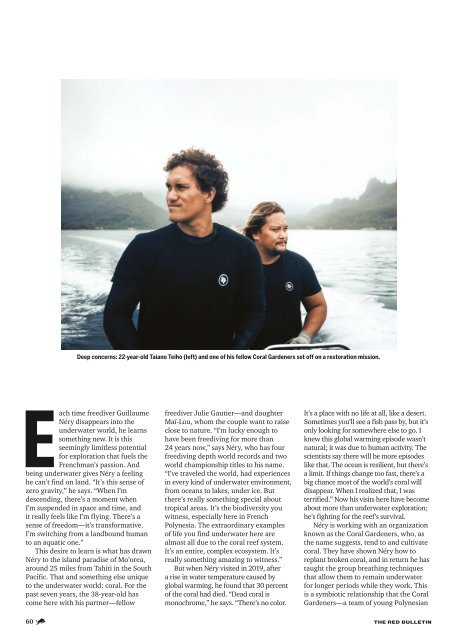Create successful ePaper yourself
Turn your PDF publications into a flip-book with our unique Google optimized e-Paper software.
Deep concerns: 22-year-old Taiano Teiho (left) and one of his fellow Coral Gardeners set off on a restoration mission.<br />
Each time freediver Guillaume<br />
Néry disappears into the<br />
underwater world, he learns<br />
something new. It is this<br />
seemingly limitless potential<br />
for exploration that fuels the<br />
Frenchman’s passion. And<br />
being underwater gives Néry a feeling<br />
he can’t find on land. “It’s this sense of<br />
zero gravity,” he says. “When I’m<br />
descending, there’s a moment when<br />
I’m suspended in space and time, and<br />
it really feels like I’m flying. <strong>The</strong>re’s a<br />
sense of freedom—it’s transformative.<br />
I’m switching from a landbound human<br />
to an aquatic one.”<br />
This desire to learn is what has drawn<br />
Néry to the island paradise of Mo’orea,<br />
around 25 miles from Tahiti in the South<br />
Pacific. That and something else unique<br />
to the underwater world: coral. For the<br />
past seven years, the 38-year-old has<br />
come here with his partner—fellow<br />
freediver Julie Gautier—and daughter<br />
Maï-Lou, whom the couple want to raise<br />
close to nature. “I’m lucky enough to<br />
have been freediving for more than<br />
24 years now,” says Néry, who has four<br />
freediving depth world records and two<br />
world championship titles to his name.<br />
“I’ve traveled the world, had experiences<br />
in every kind of underwater environment,<br />
from oceans to lakes, under ice. But<br />
there’s really something special about<br />
tropical areas. It’s the biodiversity you<br />
witness, especially here in French<br />
Polynesia. <strong>The</strong> extraordinary examples<br />
of life you find underwater here are<br />
almost all due to the coral reef system.<br />
It’s an entire, complex ecosystem. It’s<br />
really something amazing to witness.”<br />
But when Néry visited in 2019, after<br />
a rise in water temperature caused by<br />
global warming, he found that 30 percent<br />
of the coral had died. “Dead coral is<br />
monochrome,” he says. “<strong>The</strong>re’s no color.<br />
It’s a place with no life at all, like a desert.<br />
Sometimes you’ll see a fish pass by, but it’s<br />
only looking for somewhere else to go. I<br />
knew this global warming episode wasn’t<br />
natural; it was due to human activity. <strong>The</strong><br />
scientists say there will be more episodes<br />
like that. <strong>The</strong> ocean is resilient, but there’s<br />
a limit. If things change too fast, there’s a<br />
big chance most of the world’s coral will<br />
disappear. When I realized that, I was<br />
terrified.” Now his visits here have become<br />
about more than underwater exploration;<br />
he’s fighting for the reef’s survival.<br />
Néry is working with an organization<br />
known as the Coral Gardeners, who, as<br />
the name suggests, tend to and cultivate<br />
coral. <strong>The</strong>y have shown Néry how to<br />
replant broken coral, and in return he has<br />
taught the group breathing techniques<br />
that allow them to remain underwater<br />
for longer periods while they work. This<br />
is a symbiotic relationship that the Coral<br />
Gardeners—a team of young Polynesian<br />
60 THE RED BULLETIN

















